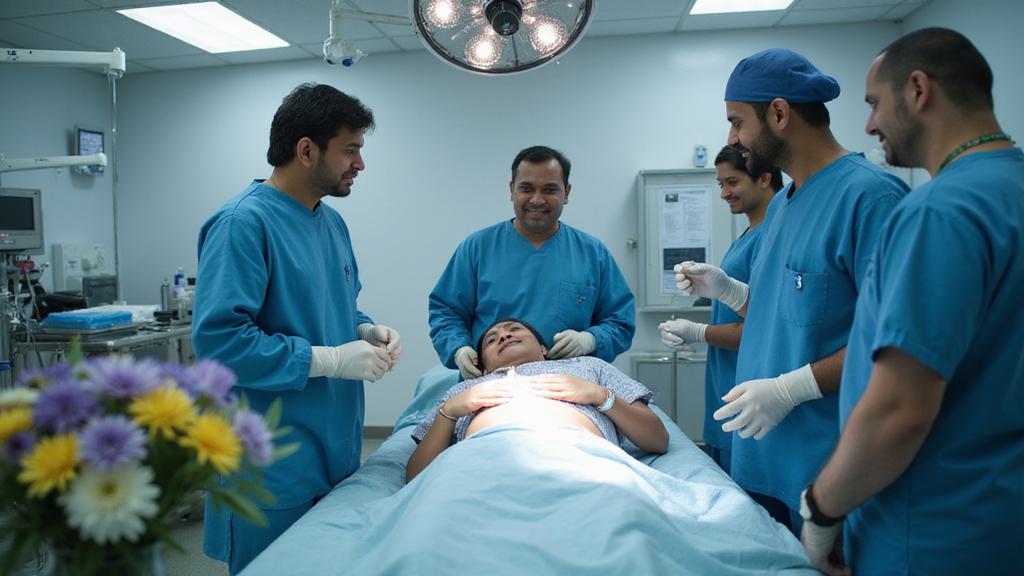If you’re grappling with the discomfort of an inguinal hernia, where abdominal tissue protrudes through a weakened groin area, you’ll find that surgical repair—often using mesh reinforcement via open or laparoscopic methods—offers a definitive solution. Performed widely in advanced facilities, such as those in India for 1,500-2,500 USD, this procedure varies by technique and patient needs. Curious about the specifics of each approach and their outcomes? There’s much more to uncover.
Key Takeaways
- Inguinal hernia repair surgery fixes tissue protrusion in the groin through open or laparoscopic techniques.
- Open repair uses a groin incision, while laparoscopic involves small incisions for faster recovery.
- Costs vary globally, with India at 1,000-2,000 USD, much lower than the US at 7,000-12,000 USD.
- Recovery takes 1-2 weeks for minimally invasive methods, compared to 4-6 weeks for open surgery.
- Success rates are high, with low recurrence (3.8%) and improved quality of life post-surgery.
An inguinal hernia, a condition where tissue protrudes through a weak spot in the abdominal muscles near the groin, often necessitates surgical intervention to prevent complications such as strangulation or obstruction, and if you’re facing this diagnosis, understanding your options is essential. As you navigate this medical challenge, you’ll encounter a variety of surgical techniques, each with distinct methodologies and outcomes, tailored to individual needs and anatomical considerations. The decision on which approach to pursue, often made in consultation with a surgeon, hinges on factors such as the hernia’s size, your overall health, and the expertise available at your medical facility.
Delving into the specifics, you might consider open repair, a traditional method where a surgeon makes an incision in the groin, repositions the protruding tissue, and reinforces the abdominal wall with sutures, often incorporating a synthetic mesh to minimize recurrence risks. Alternatively, if you’re seeking a less invasive option, laparoscopic repair—utilizing small incisions and a camera-equipped laparoscope—offers benefits like reduced postoperative discomfort and a swifter recovery, as noted in numerous clinical studies. Within this category, the Total Extraperitoneal (TEP) Repair stands out, requiring advanced skills to avoid entering the abdominal cavity, thereby lowering certain risks. Notably, TEP is recognized as a safe and cost-effective method safe and cost-effective with minimal complications when performed by experienced surgeons. For those with access to cutting-edge technology, robot-assisted repair, which employs robotic arms for enhanced precision, provides another avenue, though it demands specialized training and equipment.
Beyond these, if you’re in a region where mesh isn’t readily available or if you prefer to avoid synthetic materials, the mesh-free technique using a strip of external oblique aponeurosis to fortify the inguinal canal’s posterior wall presents a viable choice. Research involving 400 patients has demonstrated its efficacy, with minimal recurrence and a return to work within 1-2 weeks. This method, developed in response to mesh unavailability in rural areas, offers an accessible alternative accessible alternative for many patients. Regardless of the method you select, postoperative care remains paramount; you’ll need to prioritize early mobility to prevent complications while strictly avoiding heavy lifting. Regular follow-up appointments will guarantee any issues are promptly addressed, safeguarding your recovery. As you weigh these options, engaging with healthcare providers to understand the nuances of each procedure will empower you to make an informed decision tailored to your circumstances.
Overview
Inguinal hernia repair surgery addresses a common condition where tissue, such as part of the intestine, protrudes through a weak spot in the abdominal wall in the groin area. This type of hernia can cause discomfort, pain, or even serious complications if left untreated, as the protruding tissue may become trapped or strangulated. Treatment options primarily involve surgical intervention, with two main approaches: open surgery, which uses a single larger incision, and laparoscopic surgery, a minimally invasive technique involving smaller incisions and a camera. The goal of both methods is to strengthen the abdominal wall, often using a mesh to prevent further bulging. This treatment is necessary for individuals experiencing symptoms like pain or swelling in the groin, as well as those at risk of complications, particularly if the hernia is enlarging or causing significant discomfort. Surgery is often recommended to prevent severe issues (bowel obstruction risk) that could arise from an untreated hernia. Emergency surgery may be required for incarcerated or strangulated hernias to restore blood supply and avoid life-threatening conditions (emergency intervention needed).
Treatment Details and Key Information
Inguinal hernia repair surgery is a common procedure performed in big corporate hospitals in India, which are well-equipped with advanced technology and experienced surgical teams, making them a preferred choice for foreign patients seeking high-quality care at competitive costs. These hospitals offer complete treatment packages that include pre-surgical assessments, state-of-the-art surgical techniques, and personalized postoperative care. The hospital stay typically ranges from 1 to 2 days for minimally invasive procedures like laparoscopic or robotic surgery, while open surgery may require 2 to 3 days. Total recovery time varies, with minimally invasive techniques allowing a return to normal activities in 1 to 2 weeks, whereas open surgery may take 4 to 6 weeks. The procedure itself can last from 30 minutes to 2 hours, depending on the complexity of the hernia and the chosen technique. Available procedures include open surgery, which involves a larger incision and is often more affordable but has a longer recovery time; laparoscopic surgery, which uses small incisions for faster recovery but requires specialized skills; and robotic surgery, which offers enhanced precision and visibility, though it is more expensive. Each method may utilize mesh placement or sutures to reinforce the abdominal wall, with the choice depending on the patient’s condition and surgeon’s recommendation. Inguinal hernias, accounting for about 75% of abdominal wall hernias, often require surgical intervention to prevent complications like incarceration or strangulation 75% of hernias. Globally, over 20 million hernia surgeries are performed annually, with inguinal hernias being the most common type 20 million surgeries.
Key Benefits & Advantages
Inguinal hernia repair surgery offers numerous benefits, making it a preferred treatment option for many patients, especially in India. Choosing this treatment in India provides access to world-class medical facilities, highly skilled surgeons, and advanced surgical techniques like laparoscopic and mesh repair at a fraction of the cost compared to Western countries. The success rates for inguinal hernia repair in India are impressive, with both open and keyhole surgeries boasting low recurrence rates and high effectiveness in providing long-term relief from symptoms. Patients experience reduced risks of complications such as tissue strangulation, improved quality of life, and quicker recovery times, particularly with minimally invasive options. Additionally, India offers shorter hospital stays, often allowing same-day or next-day discharge, and easy aftercare, making it a convenient choice for both domestic and international patients. Surgery also helps prevent future issues by addressing the hernia before it grows larger or causes severe pain preventing future complications.
| Country | Average Cost of Inguinal Hernia Repair (USD) | Affordability Notes |
|---|---|---|
| India | 1,500 – 2,500 | Highly affordable with quality care |
| United States | 7,000 – 12,000 | Substantially more expensive |
| United Kingdom | 5,000 – 8,000 | Costly compared to India |
| Australia | 6,000 – 10,000 | High costs with longer waiting times |
| Singapore | 4,000 – 6,000 | More expensive than India but closer in region |
Treatment Process
The treatment process for inguinal hernia repair surgery begins with a thorough diagnosis and preparation phase. Prior to surgery, diagnostic procedures such as a physical examination are conducted to confirm the presence and size of the hernia, often supplemented by imaging tests like an ultrasound or CT scan to assess the extent of the protrusion and rule out complications. Pre-surgery preparations include a detailed discussion between the patient and surgeon regarding the choice of surgical technique—open or laparoscopic—and anesthesia options, which may be general, regional, or local based on medical history and personal preference. Patients are typically advised to fast for several hours before the procedure and may need to adjust or stop certain medications as directed by their healthcare provider. On the day of surgery, for open repair, a 6-8 cm incision is made in the groin to access the hernia, the bulging tissue is repositioned or removed, and the abdominal wall is reinforced with sutures and often mesh before closing the incision. In laparoscopic repair, three to five small incisions are made to insert a laparoscope and instruments, the abdominal cavity is inflated with gas for better visibility, the hernia is repaired similarly with sutures and mesh, and the incisions are closed. Both techniques aim to restore the abdominal wall’s integrity and prevent recurrence.
Expected Outcomes
Patients undergoing inguinal hernia repair surgery can generally expect positive outcomes with a high likelihood of success. Most individuals experience a significant reduction in groin pain within two weeks post-surgery, with sustained improvement observed up to five years. Long-term effectiveness is notable, as the procedure often enhances quality of life through reduced pain and fewer complications over time. Success rates are high, with recurrence rates reported at approximately 3.8%, typically occurring within a mean time of 12 months. However, there are risks to note, including postoperative complications such as hypoaesthesia (5.2%), haematoma/seroma (4.8%), urinary retention (1.3%), and chronic pain syndrome (1.2%). While these risks are relatively low, they can impact recovery and long-term comfort if they occur.
After-Treatment Care & Recovery
After undergoing inguinal hernia repair surgery, proper after-treatment care and recovery are essential for a smooth healing process. Patients are typically prescribed painkillers such as paracetamol or ibuprofen to manage discomfort, and regular follow-up appointments with healthcare providers are essential to monitor progress and address any concerns. While physiotherapy may not always be required, gentle movement like walking is encouraged to aid recovery, though strenuous activities and heavy lifting should be avoided for at least 4 to 6 weeks. Necessary precautions during the recovery phase include keeping the wound clean and dry, using waterproof dressings if showering before the wound heals, and avoiding bathing for about 2 weeks or until the incision is sufficiently healed. Lifestyle changes are also important, such as gradually increasing activity levels, making temporary workplace adjustments to avoid heavy tasks, maintaining a balanced diet, staying hydrated, and prioritizing restful sleep to support the body’s healing process.
References
- https://pmc.ncbi.nlm.nih.gov/articles/PMC2999778/
- https://www.youtube.com/watch?v=bVuOMua60NU
- https://pubmed.ncbi.nlm.nih.gov/11355734/
- https://www.maxhealthcare.in/our-specialities/minimal-access-laparoscopic-surgery/conditions-treatments/inguinal-hernia
- https://www.gastrosurgeonindia.com/gi-conditions/inguinal-hernia-surgery-hyderabad/
- https://www.nhs.uk/conditions/inguinal-hernia-repair/
- https://medlineplus.gov/ency/article/007406.htm
- https://www.ncbi.nlm.nih.gov/books/NBK459309/
- https://www.nhs.uk/conditions/inguinal-hernia-repair/what-happens/
- https://www.mountsinai.org/health-library/surgery/inguinal-hernia-repair

